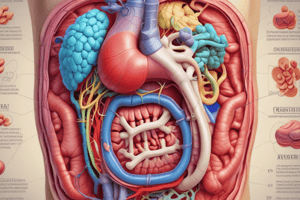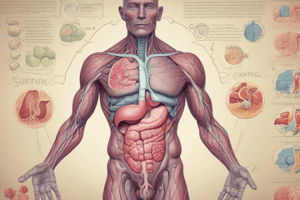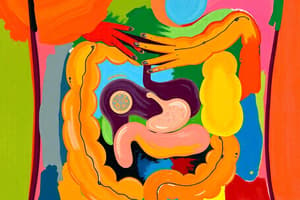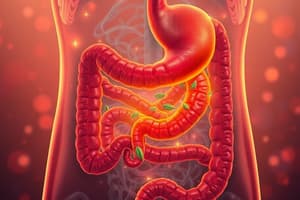Podcast
Questions and Answers
Which of the following is NOT a class of food humans consume?
Which of the following is NOT a class of food humans consume?
- Proteins
- Minerals (correct)
- Carbohydrates
- Fats
Into what smaller units are proteins digested?
Into what smaller units are proteins digested?
- Amino acids (correct)
- Monosaccharides
- Monoglycerides
- Fatty acids
What is the primary location for absorption of nutrients?
What is the primary location for absorption of nutrients?
- Esophagus
- Small intestine (correct)
- Stomach
- Large intestine
What is the primary function of peristalsis in the digestive tract?
What is the primary function of peristalsis in the digestive tract?
What are fats (triglycerides) digested into?
What are fats (triglycerides) digested into?
What process is required for the active transport of raw materials into a cell?
What process is required for the active transport of raw materials into a cell?
Which action describes segmentation in the small intestine?
Which action describes segmentation in the small intestine?
What type of contractions occur in the large intestine?
What type of contractions occur in the large intestine?
What is a key function of muscular contractions within the digestive tract?
What is a key function of muscular contractions within the digestive tract?
What makes the gastrointestinal (GI) system unique compared to other peripheral organs?
What makes the gastrointestinal (GI) system unique compared to other peripheral organs?
What is the primary function of the gastrointestinal (GI) system?
What is the primary function of the gastrointestinal (GI) system?
What is another name for the main part of the gastrointestinal tract?
What is another name for the main part of the gastrointestinal tract?
Which of the following is a key area of focus when studying the GI system?
Which of the following is a key area of focus when studying the GI system?
What are the two key processes that the GI system is responsible for regarding food?
What are the two key processes that the GI system is responsible for regarding food?
Which field of study is useful for understanding the underlying physiological principles of the GI system?
Which field of study is useful for understanding the underlying physiological principles of the GI system?
What is the approximate length of the oesophagus?
What is the approximate length of the oesophagus?
Which of the following is the primary function of the oesophagus in digestion?
Which of the following is the primary function of the oesophagus in digestion?
Which part of the digestive system lies between the oesophagus and the small intestine?
Which part of the digestive system lies between the oesophagus and the small intestine?
What type of digestion primarily occurs in the stomach, facilitated by pepsin?
What type of digestion primarily occurs in the stomach, facilitated by pepsin?
Which of these substances can be absorbed directly in the stomach?
Which of these substances can be absorbed directly in the stomach?
What is the shortest part of the small intestine called?
What is the shortest part of the small intestine called?
From which organs does the duodenum receive digestive secretions?
From which organs does the duodenum receive digestive secretions?
What is the primary function of the small intestine?
What is the primary function of the small intestine?
What is mainly absorbed in the large intestine?
What is mainly absorbed in the large intestine?
What system do both the small and large intestines rely on?
What system do both the small and large intestines rely on?
Which of the following is a digestive organ?
Which of the following is a digestive organ?
What is the primary function of sphincters in the GI tract?
What is the primary function of sphincters in the GI tract?
Which of the following is an exocrine function of the pancreas?
Which of the following is an exocrine function of the pancreas?
Which accessory organ stores and concentrates bile?
Which accessory organ stores and concentrates bile?
Nutrient laden blood is received by which organ from the portal vein?
Nutrient laden blood is received by which organ from the portal vein?
Which layer of the GIT contains blood vessels and secretory glands?
Which layer of the GIT contains blood vessels and secretory glands?
Which type of mucosa is mainly for protection?
Which type of mucosa is mainly for protection?
Where is skeletal muscle found in the GIT?
Where is skeletal muscle found in the GIT?
What is the term for crushing and grinding of food in the stomach?
What is the term for crushing and grinding of food in the stomach?
What is the function of 'tone' contractility in the digestive system?
What is the function of 'tone' contractility in the digestive system?
What type of transport is required for some carbohydrates and amino acids to cross the cell membrane?
What type of transport is required for some carbohydrates and amino acids to cross the cell membrane?
Which of the following substances can typically cross the cell membrane freely?
Which of the following substances can typically cross the cell membrane freely?
Approximately how much fluid enters the gastrointestinal tract (GIT)?
Approximately how much fluid enters the gastrointestinal tract (GIT)?
How much fluid is typically lost from the gastrointestinal tract?
How much fluid is typically lost from the gastrointestinal tract?
What is the name given to the immune defense system associated with the gastrointestinal tract?
What is the name given to the immune defense system associated with the gastrointestinal tract?
Which of the following is a primary function of the gastrointestinal tract?
Which of the following is a primary function of the gastrointestinal tract?
Which of the following conditions affects the gastrointestinal system?
Which of the following conditions affects the gastrointestinal system?
Besides the Central Nervous System (CNS), what other system regulates the Gastrointestinal Tract (GIT)?
Besides the Central Nervous System (CNS), what other system regulates the Gastrointestinal Tract (GIT)?
Flashcards
GI System Function
GI System Function
Breaks down and absorbs foods and liquids.
Alimentary Canal
Alimentary Canal
The continuous digestive tract from mouth to anus.
Main GIT
Main GIT
The main part of the GI system, runs from mouth to anus.
Gastrointestinal Physiology
Gastrointestinal Physiology
Signup and view all the flashcards
GI Tract Goal
GI Tract Goal
Signup and view all the flashcards
Peristalsis
Peristalsis
Signup and view all the flashcards
Segmentation
Segmentation
Signup and view all the flashcards
Haustral Contractions
Haustral Contractions
Signup and view all the flashcards
Intestinal Lumen Propulsion
Intestinal Lumen Propulsion
Signup and view all the flashcards
Enteric Nervous System (ENS)
Enteric Nervous System (ENS)
Signup and view all the flashcards
GI Organs
GI Organs
Signup and view all the flashcards
GI Sphincters
GI Sphincters
Signup and view all the flashcards
Accessory Digestive Organs
Accessory Digestive Organs
Signup and view all the flashcards
Mucosa Layers
Mucosa Layers
Signup and view all the flashcards
Submucosa Composition
Submucosa Composition
Signup and view all the flashcards
Muscle Layers of GIT
Muscle Layers of GIT
Signup and view all the flashcards
Squamous Mucosa Function
Squamous Mucosa Function
Signup and view all the flashcards
Gastric Mucosa Function
Gastric Mucosa Function
Signup and view all the flashcards
Intestinal Mucosa Function
Intestinal Mucosa Function
Signup and view all the flashcards
Propulsion in GI Motility
Propulsion in GI Motility
Signup and view all the flashcards
What is Secretion?
What is Secretion?
Signup and view all the flashcards
Secretion Energy Demand
Secretion Energy Demand
Signup and view all the flashcards
Digestion Products
Digestion Products
Signup and view all the flashcards
Why are enzymes needed for digestion?
Why are enzymes needed for digestion?
Signup and view all the flashcards
Absorption Definition
Absorption Definition
Signup and view all the flashcards
Active Transport in Digestion
Active Transport in Digestion
Signup and view all the flashcards
Lipid Absorption
Lipid Absorption
Signup and view all the flashcards
Other GIT functions
Other GIT functions
Signup and view all the flashcards
Common GI Conditions
Common GI Conditions
Signup and view all the flashcards
Primary role of the GIT
Primary role of the GIT
Signup and view all the flashcards
GIT Regulation Levels
GIT Regulation Levels
Signup and view all the flashcards
Immune defense (GALT)
Immune defense (GALT)
Signup and view all the flashcards
Oesophagus Function
Oesophagus Function
Signup and view all the flashcards
Secondary Peristalsis Control
Secondary Peristalsis Control
Signup and view all the flashcards
Stomach Function
Stomach Function
Signup and view all the flashcards
Small Intestine Sections
Small Intestine Sections
Signup and view all the flashcards
Duodenum's Role
Duodenum's Role
Signup and view all the flashcards
Small Intestine Motility
Small Intestine Motility
Signup and view all the flashcards
Large Intestine Functions
Large Intestine Functions
Signup and view all the flashcards
Intestines' Nervous System
Intestines' Nervous System
Signup and view all the flashcards
Digestive Secretions
Digestive Secretions
Signup and view all the flashcards
Gut Autonomy
Gut Autonomy
Signup and view all the flashcards
Study Notes
Introduction to the Gastrointestinal System
- The gastrointestinal (GI) system is responsible for breaking down and absorbing foods and liquids.
- The main GIT is made up of the alimentary canal, which runs from the mouth to the anus.
- Organs include the mouth, oesophagus, stomach, small and large intestines.
Sphincters of the GI Tract
- Sphincters in the GI tract are specialized circular muscles.
- They separate two adjacent organs.
- They act as one-way valves to prevent backward movement of intraluminal contents.
- Exceptions to this one way valve function exist with the internal and external anal sphincters.
- Sphincters have ongoing contractile tone, contracting or relaxing as needed.
Accessory Digestive Organs
- Pancreas
- The pancreas has both endocrine, such as insulin and glucagon, and exocrine functions, such as digestive enzymes and buffers.
- Gall Bladder
- The gall bladder concentrates and stores bile for lipid digestion.
- Liver
- The liver receives nutrient-laden blood from the portal vein.
- It is involved in reabsorption and secretion of nutrients.
- It also produces bile and participates in carbohydrate metabolism by processing glycogen and glucose.
General Structure of the GIT
- Mucosa
- The mucosa consists of an epithelial layer (villi or crypts), lamina propria, and muscularis mucosae.
- Submucosa
- The submucosa contains connective tissue, blood vessels, and secretory glands.
- Muscle Layers
- The GIT musculature has inner circular and outer longitudinal layers.
- Enteric Nervous System
- The enteric nervous system helps to regulate and coordinate digestive processes.
- Serosa
- The serosa is the outermost layer of the GIT.
Basic Mucosal Types
- Squamous mucosa is protective.
- Gastric mucosa is secretory.
- Intestinal mucosa is absorptive.
- Colorectal mucosa is absorptive and protective.
Musculature of the GIT
- Skeletal Muscle
- Found in the mouth, pharynx, upper third of the oesophagus, and external anal sphincter.
- Smooth Muscle
- Located everywhere else in the GIT, featuring specialized pacemaker cells for motility.
Patterns of GI Motility
- Propulsion
- Propulsion involves controlled movement of foods, liquids, secretions, and sloughed cells.
- Tituration
- Tituration involves the crushing and grinding of food by the stomach.
- Mixing Function
- Mixing includes the blending of GI secretions.
- Reservoir
- Holding of luminal content via sphincters
Primary Modes of Contractility
- Tone
- Maintains steady pressure on the contents of the digestive system.
- Prevents walls from remaining permanently stretched after distension.
- Muscular contractions
- Move contents along the tract (peristalsis)
- Mix the contents in the digestive tract
Peristalsis
- Peristalsis is the organized propulsion of material within the intestinal lumen.
Segmentation
- Segmentation mixes and propels chyme in the small intestine.
- Smooth muscle contracts, relaxes, then contracts in a different place (oscillating).
- Large intestine exhibits haustral contractions.
Enteric Nervous System (ENS)
- The GI system differs from other peripheral organs due to the ENS.
- It has an extensive intrinsic nervous system.
- It is vast, consisting of 200-600 million neurons.
Distribution of Enteric Ganglia
- Myenteric: mainly controls motility (except in the stomach, where it also controls secretion)
- Submucosal: mainly controls secretomotor and vasomotor functions
Mouth
- Digestion begins in the mouth; the first step can begin even before food is present.
- The cephalic phase of digestion starts when you see or smell food.
- This leads to salivation, gastric relaxation, and gastric acid secretion.
- Chewing depends on a motor pattern generator located in the brain stem.
- The tongue is a voluntary set of muscles controlled via the motor cortex.
- Swallowing is another voluntary process.
Pharynx
- The pharynx has three sections: the nasopharynx, oropharynx, and laryngopharynx.
- It moves the bolus of food towards the oesophagus via muscular contractions.
Esophagus
- The esophagus is a muscular tube about 25 cm long.
- It serves as a conduit to pass food from the mouth to the stomach.
- Its digestive function is food propulsion.
- Primary peristalsis is controlled by the CNS via the vagus nerve.
- The enteric nervous system also plays a role via secondary peristalsis.
Stomach
- The stomach is a thick-walled organ between the oesophagus and the first part of the small intestine.
- It facilitates mechanical digestion and propulsion.
- The stomach also handles chemical digestion, through the digestion of proteins by pepsin.
- Absorption of a few fat-soluble substances, like aspirin and alcohol, occurs here.
Small Intestine (~6m)
- Duodenum
- This is the shortest part of the small intestine.
- It receives secretions from the pancreas and gall bladder.
- Jejunum and ileum
- Begins at duodenaljejunal flexure and ends at ileocaecal junction.
- Assimilation of nutrients
- Secretions for digestion and absorption.
- Motility mixes contents and increases surface area.
- It controls delivery of chyme from the stomach.
- Regulates secretion of biliary and pancreatic secretions.
Large Intestine (~1m)
-
There is chemical digestion, where some remaining food residues are digested by enteric bacteria.
-
Absorption primarily involves water, electrolytes, and bacteria-produced vitamins.
-
Propulsion is important for movement.
-
Defecation
Secretion in the GI Tract
- A number of secretions are produced along the GI tract.
- Digestive secretions consist of water, electrolytes, and organic constituents such as enzymes, bile salts, or mucus.
- Secretion demands energy, involving active transport of raw materials into the cell, sometimes with passive diffusion.
Digestion
- Humans consume three classes of food: carbohydrates, proteins, and fats.
- Carbohydrates are digested into monosaccharides, mostly glucose.
- Proteins are digested into amino acids and a few small polypeptides.
- Fats (triglycerides) digested into monoglycerides and free fatty acids.
- These molecules cannot be absorbed directly as they are too large so must be chemically degraded to smaller absorbable units by enzymes.
Absorption
- Most absorption occurs in the small intestine.
- Small absorbable molecules, H2O, vitamins, electrolytes, are transferred from the digestive tract lumen to the plasma or lymph.
- Some molecules have to be moved by active transport, like CHO and AAs.
- Lipids can cross the cell membrane freely.
Other Functions of the GIT
- Fluid and electrolyte balance with 9 L into GIT and 0.1L lost.
- It plays a role in immune defence (GALT) with lymphoid tissue aggregates and diffuse cells.
- It is a site of uptake for medicines.
- It is a barrier.
- The gut microbiota plays a role.
GI Conditions
- Stomach and duodenal ulcers
- Coeliac's disease
- IBD
- Dysphagia
- Conditions of the ENS
- Cancers
- Gall bladder stones
- Pancreatic insufficiency
- Liver disease
- Parasites, bacteria & viruses
Key points
- The GIT involves multiple organs and "accessory” organs
- The structure and function of the GIT differs along its length
- The primary function of the GIT is to digest and absorb nutrients for us to assimilate
- This differs for each food class; fat, carbohydrate and protein
- There are multiple levels of regulation for the GIT: hormones, CNS, ENS, humoral factors
Studying That Suits You
Use AI to generate personalized quizzes and flashcards to suit your learning preferences.




